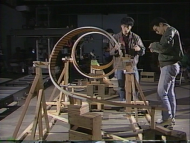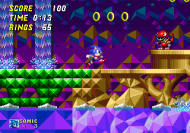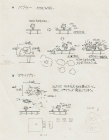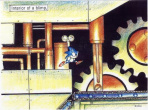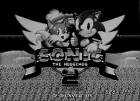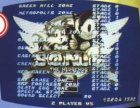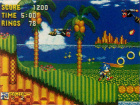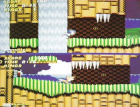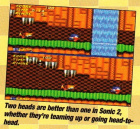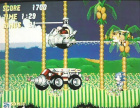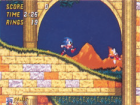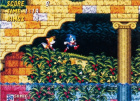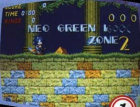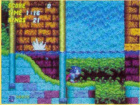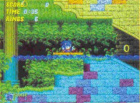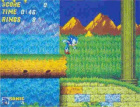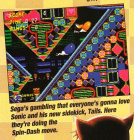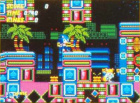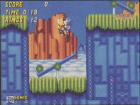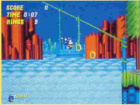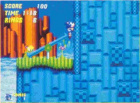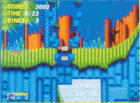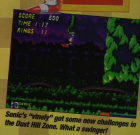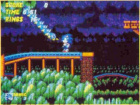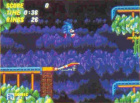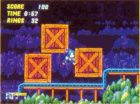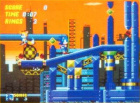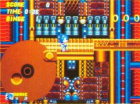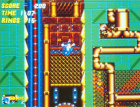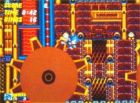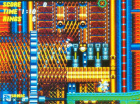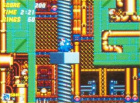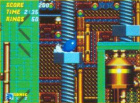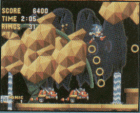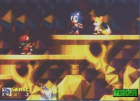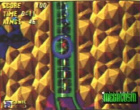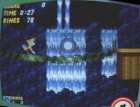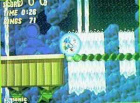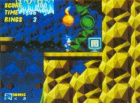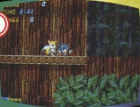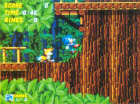Difference between revisions of "Sonic the Hedgehog 2 (16-bit)/Development"
From Sonic Retro
m (→Development Process) |
(Just adding more of what was missing.) |
||
| Line 22: | Line 22: | ||
With the American and Japanese teams having very different approaches to using color in the zone art and in creating the level layouts themselves, it was up to the senior members of the Japanese staff to help unify the look of the final product, cutting through the cultural differences to provide the best product they could muster in the time allowed. | With the American and Japanese teams having very different approaches to using color in the zone art and in creating the level layouts themselves, it was up to the senior members of the Japanese staff to help unify the look of the final product, cutting through the cultural differences to provide the best product they could muster in the time allowed. | ||
| + | [[Image:Hiddenpalaces2.png|right|thumb|190px|The much-discussed Hidden Palace Zone.]] | ||
Even if tensions could rise as the leaders of the project demanded perfection, work on ''Sonic the Hedgehog 2'' continued unfettered. With each passing day, the hype behind the project grew more and more, immense pressure being put on the collective team. Not content with just the random screenshot from time to time, Sega wanted to advertise the game in as many ways possible. Getting in contact with the children's network Nickelodeon, a special cartridge was put together to be played on the gameshow [[Nick Arcade]], featuring an early version of Emerald Hill. This prototype, later referred to as the "[[Sonic the Hedgehog 2 (Nick Arcade prototype)|Nick Arcade prototype]]," was eventually leaked onto the Internet in 2006. Sometime after the airing of the show, another early build was put together to help drum up interest, being a playable demo to the public at a New York toy show. However, security was not up to snuff, and at the end the [[Yuji Naka interview by GameSpy (September 2005)|cartridge was stolen]]. Later to be known as the [[Sonic the Hedgehog 2 (Simon Wai prototype)|"Simon Wai" prototype]] (named after the man who discovered the ROM image on the Internet back in 1999) it was this build that was the source of many prerelease information related to the game. | Even if tensions could rise as the leaders of the project demanded perfection, work on ''Sonic the Hedgehog 2'' continued unfettered. With each passing day, the hype behind the project grew more and more, immense pressure being put on the collective team. Not content with just the random screenshot from time to time, Sega wanted to advertise the game in as many ways possible. Getting in contact with the children's network Nickelodeon, a special cartridge was put together to be played on the gameshow [[Nick Arcade]], featuring an early version of Emerald Hill. This prototype, later referred to as the "[[Sonic the Hedgehog 2 (Nick Arcade prototype)|Nick Arcade prototype]]," was eventually leaked onto the Internet in 2006. Sometime after the airing of the show, another early build was put together to help drum up interest, being a playable demo to the public at a New York toy show. However, security was not up to snuff, and at the end the [[Yuji Naka interview by GameSpy (September 2005)|cartridge was stolen]]. Later to be known as the [[Sonic the Hedgehog 2 (Simon Wai prototype)|"Simon Wai" prototype]] (named after the man who discovered the ROM image on the Internet back in 1999) it was this build that was the source of many prerelease information related to the game. | ||
| − | |||
Even knowing early on they would not have enough time to work on everything they had set out to in the beginning, as the release date drew nearer it became more than obvious that the team would have barely enough time to finish the eleven zones that ended up in the final game. [[Genocide City Zone|Cyber City Zone]], a one-act level that was meant to follow [[Metropolis Zone]] (and was briefly called "Genocide City" but changed once the Japanese staff fully realized what the word meant) was scrapped, most of it being converted into the third act of Metropolis. The very last level to be removed was one of the first that had been worked on, the Hidden Palace Zone. Conceived as an area Sonic would warp to after collecting all seven [[Chaos Emeralds]], both game flow and deadlines forced the team to drop it, instead awarding the power of Super Sonic immediately after the seventh special stage was completed. | Even knowing early on they would not have enough time to work on everything they had set out to in the beginning, as the release date drew nearer it became more than obvious that the team would have barely enough time to finish the eleven zones that ended up in the final game. [[Genocide City Zone|Cyber City Zone]], a one-act level that was meant to follow [[Metropolis Zone]] (and was briefly called "Genocide City" but changed once the Japanese staff fully realized what the word meant) was scrapped, most of it being converted into the third act of Metropolis. The very last level to be removed was one of the first that had been worked on, the Hidden Palace Zone. Conceived as an area Sonic would warp to after collecting all seven [[Chaos Emeralds]], both game flow and deadlines forced the team to drop it, instead awarding the power of Super Sonic immediately after the seventh special stage was completed. | ||
{{quote|1=My only complaint was that if art had to get cut out it always seemed to be the American's on the team who's art got cut. Sometimes this was because the art wasn't working, but on other occasions, I don't believe this was the case. (such as with Hidden Palace, although I never was happy with the far background).|2=Craig Stitt, Zone Artist for ''Sonic the Hedgehog 2''[http://info.sonicretro.org/Craig_Stitt_interview_by_ICEknight_(January_2001)]}} | {{quote|1=My only complaint was that if art had to get cut out it always seemed to be the American's on the team who's art got cut. Sometimes this was because the art wasn't working, but on other occasions, I don't believe this was the case. (such as with Hidden Palace, although I never was happy with the far background).|2=Craig Stitt, Zone Artist for ''Sonic the Hedgehog 2''[http://info.sonicretro.org/Craig_Stitt_interview_by_ICEknight_(January_2001)]}} | ||
| + | [[Image:S2launchusa.png|right|thumb|190px|Sega of America's CEO [[sega:Tom Kalinske|Tom Kalinske]] along with a plethora of early 90's TV stars, gathered to promote the release of ''Sonic 2''.]] | ||
To make the deadline, Sega of Japan, only a few weeks before the Christmas selling season, had thirteen additional Japanese staff members fly out to San Francisco to iron out any issues or problems the game had. Such details as the title screen were changed days before it was to be certified, and even the game credits were thrown together at the last minute, causing some people to be miscredited in terms of what they contributed to ''Sonic 2''. | To make the deadline, Sega of Japan, only a few weeks before the Christmas selling season, had thirteen additional Japanese staff members fly out to San Francisco to iron out any issues or problems the game had. Such details as the title screen were changed days before it was to be certified, and even the game credits were thrown together at the last minute, causing some people to be miscredited in terms of what they contributed to ''Sonic 2''. | ||
| Line 42: | Line 43: | ||
==Concept Art== | ==Concept Art== | ||
| + | |||
| + | ===Character Art=== | ||
| + | |||
| + | <gallery> | ||
| + | File:CollectionItem 129.png|Initial line art of Sonic and Tails used on the Japanese boxart. Scan from ''[[Sonic Generations]]''. | ||
| + | File:CollectionItem 126.png|Line art for illustrations within the Japanese manual. Scan from ''Sonic Generations''. | ||
| + | File:CS E 00.png|Dr. Eggman and his many facial expressions. Scan from ''[[Sonic Jam]]''. | ||
| + | File:CS E 03.png|Concept art of [[Eggmobile|Eggman's Mobile]]. Scan from ''Sonic Jam''. | ||
| + | </gallery> | ||
===Enemy Concept Art=== | ===Enemy Concept Art=== | ||
<gallery widths="148px" heights="140px" > | <gallery widths="148px" heights="140px" > | ||
| + | File:CollectionItem 118.png|A collection of various enemy doodles, used in the Japanese manual. Scan from ''Sonic Generations''. | ||
File:Sket banper.png|Concept art of [[Banper]]. | File:Sket banper.png|Concept art of [[Banper]]. | ||
| + | File:S2enemyconcepts18.JPG|Sketches of fleshed out, unused badniks, seemingly using springs in their design. | ||
File:Sket fishfrog.png|Concept art of the [[Frog]]. | File:Sket fishfrog.png|Concept art of the [[Frog]]. | ||
| + | File:S2badnikconcepts.jpg|Features the Frog. | ||
| + | File:S2badnikconcepts7.jpg|The Frog yet again, along with a sketch of Sonic. | ||
| + | File:S2enemyconcepts12.JPG|More of the Frog badnik. | ||
| + | File:S2frogconcept.JPG|Working out the Frog in motion. | ||
File:Sket bubbler.png|Concept art of [[Bubbler]] and [[Bubbler's Mother]]. | File:Sket bubbler.png|Concept art of [[Bubbler]] and [[Bubbler's Mother]]. | ||
| + | File:Bubblerconcept.JPG|Further art of Bubbler. | ||
| + | File:S2badnikconcepts3.jpg|Concept art of Bubbler's Mother. | ||
| + | File:S2mbubblerconcept.JPG|More of Bubbler's Mother. | ||
File:Sket bee.png|Concept art of [[Bee]]. | File:Sket bee.png|Concept art of [[Bee]]. | ||
| − | File:Sket snail.png|Concept art of a snail-like enemy. | + | File:Waspconcept.JPG|Concept art of Bee. |
| + | File:Sket snail.png|Concept art of [[Snail]]. | ||
| + | File:S2badnikconcepts4.jpg|More concept art of the snail-like enemy. | ||
| + | File:S2enemyconcepts14.JPG|Working out the sprite look for a Snail enemy. | ||
| + | File:S2enemyconcepts15.JPG|More of the snail-like enemy. | ||
| + | File:Snailconcept.JPG|Concept art for Snail. | ||
| + | File:Snailconcept2.JPG|Descriptions of the Snail enemy. | ||
File:S2crawlconcept.JPG|Concept art of [[Crawl]]. | File:S2crawlconcept.JPG|Concept art of [[Crawl]]. | ||
File:S2crawlconcept2.JPG|More Crawl concept art. | File:S2crawlconcept2.JPG|More Crawl concept art. | ||
File:S2fishconcept.JPG|Early concept art for [[Masher]]. | File:S2fishconcept.JPG|Early concept art for [[Masher]]. | ||
File:S2fishconcept2.JPG|Paper devoted to the Masher badnik. | File:S2fishconcept2.JPG|Paper devoted to the Masher badnik. | ||
| − | File: | + | File:S2badnikconcepts2.jpg|Features [[Other Scrapped Sonic 2 Badniks|Penguin]]. |
| − | |||
| − | |||
| − | |||
| − | |||
| − | |||
| − | |||
| − | |||
| − | |||
| − | |||
| − | |||
| − | |||
| − | |||
| − | |||
| − | |||
| − | |||
| − | |||
| − | |||
| − | |||
| − | |||
File:Tricerabotconcept.JPG|Concept art of [[Stego]]. | File:Tricerabotconcept.JPG|Concept art of [[Stego]]. | ||
File:Tricerabotconcept2.JPG|Further art of Stego. | File:Tricerabotconcept2.JPG|Further art of Stego. | ||
| − | File: | + | File:S2sonicenemies.jpg|Working out Stego in sprite form. |
| + | File:S2badnikconcepts5.jpg|Sketches of the various Hidden Palace dinosaur enemies. | ||
| + | File:S2badnikconcepts9.jpg|More of the dinos. | ||
| + | File:S2enemyconcepts17.JPG|Various sketches, from Hidden Palace to Dust Hill. Also a friendly reminder to buy a new pad of paper. | ||
| + | File:S2badnikconcepts10.jpg|Possible enemy ideas for Dust Hill. | ||
| + | File:S2gatorconcept.JPG|Concept art of [[Gator]]. | ||
| + | File:S2pillbugconcept.jpg|Idle drawings of Gator and an unused Pillbug, along with a sketch of Sonic. | ||
| + | File:S2badnikconcepts6.jpg|Numerous unused enemy concepts. | ||
| + | File:S2badnikconcepts8.jpg|A Spring-Orb badnik. | ||
| + | File:S2badnikconcepts11.jpg|Artwork for a squid badnik, most likely for underwater sections. | ||
| + | File:S2enemyconcepts13.JPG|Various sketches. | ||
| + | File:S2enemyconcepts16.JPG|Various sketches. | ||
| + | File:S2enemyconcepts20.jpg|Various sketches. | ||
</gallery> | </gallery> | ||
| Line 93: | Line 111: | ||
File:S2metropolisbgconcept.jpg|Early concept art of the background. Furnaces can be seen. | File:S2metropolisbgconcept.jpg|Early concept art of the background. Furnaces can be seen. | ||
File:Rhombusds.JPG|The unused diagonal elevators. | File:Rhombusds.JPG|The unused diagonal elevators. | ||
| + | File:S2obstacles3.jpg|Art of the diagonal elevators. | ||
| + | File:S2mtzchunks.jpg|Art of various elements to the Metropolis design. | ||
| + | File:S2obstacles.jpg|Concept art for various obstacles. Drawn on STI letterhead. | ||
| + | File:S2obstacles2.jpg|Concept art for various obstacles. Drawn on STI letterhead. | ||
| + | File:S2obstacles4.jpg|Concept art for various obstacles. | ||
| + | File:S2obstacles5.jpg|Concept art for various obstacles. | ||
| + | File:S2obstacles6.jpg|Concept art for various obstacles. | ||
| + | File:S2gearconcept.jpg|Concept art of the iconic gears. | ||
| + | File:S2gearconcept2.jpg|More of the gears. | ||
| + | File:S2obstaclelist.jpg|A list of obstacles slated for use, including those unused. | ||
File:Metropolis1a.jpg|Early Act 1 map. Has diagonally slanted rotating steel drums. Very different from final. Only two things seem very similar to final; the general positioning of the starting area, and the short downward ramp leading to a flat area with the end sign. | File:Metropolis1a.jpg|Early Act 1 map. Has diagonally slanted rotating steel drums. Very different from final. Only two things seem very similar to final; the general positioning of the starting area, and the short downward ramp leading to a flat area with the end sign. | ||
File:Metropolis2a.jpg|Early Act 2 map. Has giant crusher. Very different from final. Aside from the immediate starting area and an area with a half-loop leading to a ramp in the top-left, almost nothing recognizable remains. | File:Metropolis2a.jpg|Early Act 2 map. Has giant crusher. Very different from final. Aside from the immediate starting area and an area with a half-loop leading to a ramp in the top-left, almost nothing recognizable remains. | ||
| Line 113: | Line 141: | ||
===Objects=== | ===Objects=== | ||
<gallery widths="148px" heights="140px" > | <gallery widths="148px" heights="140px" > | ||
| − | Image:Sket ball.png|A bouncing ball which was scrapped before release. Its sprites | + | Image:Sket ball.png|A bouncing ball which was scrapped before release. Its [[:File:Spr ball.gif|sprites]] were located in a prototype version in Oil Ocean Zone. |
File:RollingBallConceptArt.jpg|More bouncing ball concept art. Taken from [[:File:S2badnikconcepts2.jpg|this file]]. | File:RollingBallConceptArt.jpg|More bouncing ball concept art. Taken from [[:File:S2badnikconcepts2.jpg|this file]]. | ||
File:S2ballframes.jpg|Page dealing with the frames of the bouncing ball. | File:S2ballframes.jpg|Page dealing with the frames of the bouncing ball. | ||
File:S2ballthingy.jpg|Artwork of the bouncing ball in full color. | File:S2ballthingy.jpg|Artwork of the bouncing ball in full color. | ||
| + | File:S2gczconcepts.jpg|Concepts of various items belonging to Cyber City. | ||
</gallery> | </gallery> | ||
| Line 123: | Line 152: | ||
<gallery widths="148px" heights="140px" > | <gallery widths="148px" heights="140px" > | ||
File:S2spritesystem.jpg|Explanation of the sprite system. | File:S2spritesystem.jpg|Explanation of the sprite system. | ||
| + | File:S2spritelist.jpg|List of sprites. | ||
File:S2TASKLIST.jpg|Task list from which Tom Payne worked with. | File:S2TASKLIST.jpg|Task list from which Tom Payne worked with. | ||
| + | File:S2tasklist2.jpg|A more informal list of tasks Tom Payne had to do. | ||
File:S2paldata.jpg|File dealing with the palette data of the game. | File:S2paldata.jpg|File dealing with the palette data of the game. | ||
File:S2lavabubds.JPG|Information about a lava bubbling animation. | File:S2lavabubds.JPG|Information about a lava bubbling animation. | ||
| + | File:Collisionarray.jpg|Information on the collision array of ''Sonic 2.'' | ||
| + | File:Collisionarray2.jpg|More on the collision array. | ||
| + | File:Collisionarray3.jpg|More on the collision array. | ||
| + | File:Collisionarray4.jpg|More on the collision array. | ||
| + | File:Collisionarray5.jpg|More on the collision array. | ||
| + | File:Col4 29.jpg|More on the collision array. | ||
| + | File:S2enemylevels.jpg|A list determining which enemies go with which stage. | ||
File:S2sludgehog.jpg|A joke image of Sonic brandishing a gun, unknowingly foreshadowing the game ''[[Shadow the Hedgehog (game)|Shadow the Hedgehog]]''. | File:S2sludgehog.jpg|A joke image of Sonic brandishing a gun, unknowingly foreshadowing the game ''[[Shadow the Hedgehog (game)|Shadow the Hedgehog]]''. | ||
</gallery> | </gallery> | ||
Revision as of 01:00, 27 February 2013
Sonic the Hedgehog 2 went through many ideas and changes during the development process. What follows is a collection of items related to the game's development.
Development Process
After the tremendous success of Sonic the Hedgehog, it was only natural to expect a sequel to the game. Though many would have assumed the original team would be already scheduled to spearhead the second entry in the series, right off the bat problems arose that would turn the production of Sonic the Hedgehog 2 into the words legends are made of. Yuji Naka, the man responsible for the engine of the first game, had run into issues with the management of Sega of Japan. Though the game had been a success, the powers that be at the company were not happy with how everything turned out, among the disagreements the amount of time that had been spent programming the project. Growing weary of politics, Naka quit Sega, intending to look for work elsewhere. Back in the United States, Mark Cerny, the man who had come up with the gaming classic Marble Madness, had been hired by Sega to create a new gaming studio for the company, the Sega Technical Institute (STI). The general idea behind the studio was to hire talented individuals who were only getting their start in the industry and teach them the ways of the gaming development world, not only with the talent already established in the U.S. but by talent originating from Japan who had proven themselves in a far different commercial environment. Placing advertisements in local newspapers, the resumes began pouring in, with such people as Tom Payne, Brenda Ross, and future-creator of Spyro the Dragon Craig Stitt becoming employees of this new experiment in game development.
During the production of the original Sonic the Hedgehog, Mark Cerny had already secured Hirokazu Yasuhara, the director of that project, to come out to the United States and work for STI once his job back at Sega of Japan was done. However, when Cerny learned of Yuji Naka's departure from the company, he immediately called up his long-time friend, attempting to persuade him to come out to America as well and become a part of his venture. With the promise of a better salary and more executive power, Naka took Mark up on the offer, hiring back into the Sega fold.[1]
Though the American staff of STI cut their teeth on the game Kid Chameleon, with the arrival of Naka, Yasuhara, and a handful of other Japanese staff members, Cerny was sure Sega would give the team their biggest and most obvious assignment - the sequel to Sonic the Hedgehog. With two of the three main people behind the success of the first game (the third, Naoto Ohshima, stayed behind and eventually directed Sonic CD) it only made sense to devote the entire studio to Sega's biggest franchise. Even though the Japanese staff arrived in September, it would be two months until work on the sequel began.
| “ | I'd managed to reunite two of the three key Sonic Team members...at my Sega Technical Institute. They were ready to start work on their next project, and so I asked marketing the obvious question, "would you like another Sonic?" Bizarrely, the response was, and again I kid you not, "no, it's much too soon." So we found another game to make, and in November, as we were getting started, marketing came back and said "oops, we do need that game, and we need it now." So the team lost two months out of an eleven month schedule! | „ |
| — Mark Cerny, programmer for Sonic the Hedgehog 2 [2] | ||
Filled to brim with ideas, one of the first elements the team decided on was that they wanted a new main character to be introduced in the game. Before Yuji Naka agreed to become a part of the Sonic 2 team, one of his requests was that there would be a two-player mode, a feature he wanted to include in the original title but did not have the time to implement. An internal competition was held within Sonic Team and STI to find the best character that could be used for this new addition to the franchise, and though many entries were submitted (including one from artist Craig Stitt for a flying turtle named "Boomer") it was Yasushi Yamaguchi who won with his two-tailed fox character. Originally wanting him to be named "Miles Prower," the rest of the team felt his name should simply be "Tails," to match the simplistic nature of Sonic's name. Unhappy with this idea, Yamaguchi (who became the lead zone artist in the game) decided to sneak the name "Miles Prower" into various concept art and in the game, making both names legitimate in the end.
Being nothing less than ambitious, the original plan was to make a sprawling, 18-zone epic, revisiting the unique level tropes Sonic Team had created for the first game, putting their own spin on traditional platformer levels like desert and snow worlds, and even come up with some ideas that would be totally new. Emerald Hill, Hill Top, Oil Ocean, Hidden Palace, Dust Hill and the never-titled Winter Zone were some of the first levels to be worked on, the concept of time travel also being talked about in early production meetings. However, it became obvious early on that if they were to have the game ready for the Christmas season of 1992, they could not finish every world that was on the drawing board. The time travel concept was dropped almost immediately, and Dust Hill and its winter counterpart were some of the first zones to be put on the chopping block, much to the chagrin of Brenda Ross, the artist responsible for their look.[3]
Though the two sides of STI tried to work together, the language barrier proved to be too much at times. Most of the meetings for the direction of Sonic the Hedgehog 2 were done in Japanese (Mark Cerny being fluent in the language), leaving the American side in the dust. Trying to mesh the two cultures and work ethics became a challenge in itself, with some members unable to get along with Yuji Naka's intense personality. Tom Payne, who himself never had any issues with the Japanese half of the team, recalled in an interview later the stark differences between the American mindset of a nine-to-five job and the Japanese mindset of working almost all hours of the night, with members like Yamaguchi and Yasuhara being extremely passionate with the quality of the whole:
| “ | Well for me-- this was my first job so I only had Sonic 1 to go by & tried to make it match that style. I'd say [that] it was Yamaguchi who laid out the look. He would stay all night & fix everything that we did wrong. Quite an amazing fellow. | „ |
| — Tom Payne, Zone Artist for Sonic the Hedgehog 2[4] | ||
With the American and Japanese teams having very different approaches to using color in the zone art and in creating the level layouts themselves, it was up to the senior members of the Japanese staff to help unify the look of the final product, cutting through the cultural differences to provide the best product they could muster in the time allowed.
Even if tensions could rise as the leaders of the project demanded perfection, work on Sonic the Hedgehog 2 continued unfettered. With each passing day, the hype behind the project grew more and more, immense pressure being put on the collective team. Not content with just the random screenshot from time to time, Sega wanted to advertise the game in as many ways possible. Getting in contact with the children's network Nickelodeon, a special cartridge was put together to be played on the gameshow Nick Arcade, featuring an early version of Emerald Hill. This prototype, later referred to as the "Nick Arcade prototype," was eventually leaked onto the Internet in 2006. Sometime after the airing of the show, another early build was put together to help drum up interest, being a playable demo to the public at a New York toy show. However, security was not up to snuff, and at the end the cartridge was stolen. Later to be known as the "Simon Wai" prototype (named after the man who discovered the ROM image on the Internet back in 1999) it was this build that was the source of many prerelease information related to the game.
Even knowing early on they would not have enough time to work on everything they had set out to in the beginning, as the release date drew nearer it became more than obvious that the team would have barely enough time to finish the eleven zones that ended up in the final game. Cyber City Zone, a one-act level that was meant to follow Metropolis Zone (and was briefly called "Genocide City" but changed once the Japanese staff fully realized what the word meant) was scrapped, most of it being converted into the third act of Metropolis. The very last level to be removed was one of the first that had been worked on, the Hidden Palace Zone. Conceived as an area Sonic would warp to after collecting all seven Chaos Emeralds, both game flow and deadlines forced the team to drop it, instead awarding the power of Super Sonic immediately after the seventh special stage was completed.
| “ | My only complaint was that if art had to get cut out it always seemed to be the American's on the team who's art got cut. Sometimes this was because the art wasn't working, but on other occasions, I don't believe this was the case. (such as with Hidden Palace, although I never was happy with the far background). | „ |
| — Craig Stitt, Zone Artist for Sonic the Hedgehog 2[5] | ||
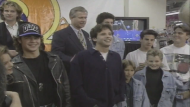
To make the deadline, Sega of Japan, only a few weeks before the Christmas selling season, had thirteen additional Japanese staff members fly out to San Francisco to iron out any issues or problems the game had. Such details as the title screen were changed days before it was to be certified, and even the game credits were thrown together at the last minute, causing some people to be miscredited in terms of what they contributed to Sonic 2.
The game was released simultaneously in the United States and Europe on "Sonic 2sday." A marketing campaign promoting the concept of "blast processing" was pursued, while back in Japan the campaign focused on the introduction of "Tails." The entire team, both American and Japanese, celebrated together on November 23rd, 1992, proud of the game that, against the odds, would not only be the biggest selling Sonic game on the Mega Drive, but the best selling game of the 16-bit era.
Just like the first game, Masato Nakamura, leader of the band DREAMS COME TRUE, was in charge of creating the soundtrack to Sonic 2. Wanting to stay faithful to what he had done in the first game but give the audience even more, Nakamura felt the pressure of writing music that would satisfy fans of the first. With the game released and receiving all sorts of praise, Nakamura decided to give something back to the team that had given him the chance to create the music in the first place.
| “ | [A]fter finishing all of the tracks for the sequel, Nakamura sent me a fax saying, "I've got a present for you. It's a surprise!" The other members of Sonic Team and I tried to figure out what it might be, but we could never have guessed that Nakamura reworked the ending theme that he provided for us for Sonic the Hedgehog 2 into a song entitled "SWEET SWEET SWEET" for inclusion on the DREAMS COME TRUE album that he worked on in London. I remember how ecstatic and moved all of us on Sonic Team were upon learning of our "present." That particular song remains a huge favorite of mine, and continues to hold very strong memories for me. For that, I am truly grateful. | „ |
| — Yuji Naka, Chief Programmer for Sonic the Hedgehog 2 [6] | ||
Also of note is the fact the game contained references to some of the biggest pop culture phenomenons on both sides of the Pacific. The Death Egg, Eggman's ultimate weapon in the game, was modeled after the Death Star, the superweapon featured in the Star Wars trilogy. Meanwhile, the seven Chaos Emeralds and the introduction of Super Sonic were homages to the well-known Chinese fable The Golden Warrior and its then-current interpretation being published in Japan, Dragon Ball.
It is also possible that a Mega CD port of Sonic the Hedgehog 2 was planned early on in the development cycle, but it was decided that the team should remain focused on the Mega Drive cart.
Concept Art
Character Art
Initial line art of Sonic and Tails used on the Japanese boxart. Scan from Sonic Generations.
Dr. Eggman and his many facial expressions. Scan from Sonic Jam.
Concept art of Eggman's Mobile. Scan from Sonic Jam.
Enemy Concept Art
- Sket banper.png
Concept art of Banper.
- S2enemyconcepts18.JPG
Sketches of fleshed out, unused badniks, seemingly using springs in their design.
- Sket fishfrog.png
Concept art of the Frog.
- S2badnikconcepts.jpg
Features the Frog.
- S2badnikconcepts7.jpg
The Frog yet again, along with a sketch of Sonic.
- S2enemyconcepts12.JPG
More of the Frog badnik.
- S2frogconcept.JPG
Working out the Frog in motion.
Concept art of Bubbler and Bubbler's Mother.
- Bubblerconcept.JPG
Further art of Bubbler.
- S2badnikconcepts3.jpg
Concept art of Bubbler's Mother.
- S2mbubblerconcept.JPG
More of Bubbler's Mother.
- Sket bee.png
Concept art of Bee.
- Waspconcept.JPG
Concept art of Bee.
- Sket snail.png
Concept art of Snail.
- S2badnikconcepts4.jpg
More concept art of the snail-like enemy.
- S2enemyconcepts14.JPG
Working out the sprite look for a Snail enemy.
- S2enemyconcepts15.JPG
More of the snail-like enemy.
- Snailconcept.JPG
Concept art for Snail.
- Snailconcept2.JPG
Descriptions of the Snail enemy.
- S2crawlconcept.JPG
Concept art of Crawl.
- S2crawlconcept2.JPG
More Crawl concept art.
- S2fishconcept.JPG
Early concept art for Masher.
- S2fishconcept2.JPG
Paper devoted to the Masher badnik.
- S2badnikconcepts2.jpg
Features Penguin.
- Tricerabotconcept.JPG
Concept art of Stego.
- Tricerabotconcept2.JPG
Further art of Stego.
- S2sonicenemies.jpg
Working out Stego in sprite form.
- S2badnikconcepts5.jpg
Sketches of the various Hidden Palace dinosaur enemies.
- S2badnikconcepts9.jpg
More of the dinos.
- S2enemyconcepts17.JPG
Various sketches, from Hidden Palace to Dust Hill. Also a friendly reminder to buy a new pad of paper.
- S2badnikconcepts10.jpg
Possible enemy ideas for Dust Hill.
- S2gatorconcept.JPG
Concept art of Gator.
- S2pillbugconcept.jpg
Idle drawings of Gator and an unused Pillbug, along with a sketch of Sonic.
- S2badnikconcepts6.jpg
Numerous unused enemy concepts.
- S2badnikconcepts8.jpg
A Spring-Orb badnik.
- S2badnikconcepts11.jpg
Artwork for a squid badnik, most likely for underwater sections.
- S2enemyconcepts13.JPG
Various sketches.
- S2enemyconcepts16.JPG
Various sketches.
- S2enemyconcepts20.jpg
Various sketches.
Level Concept Art
Metropolis Zone
- Metropolis concept.jpg
An early piece of concept art for Metropolis Zone.
- S2metropolisconcepts.jpg
Early concept art.
- S2metropolisconcepts2.jpg
Early concept art. Text humorously refer to the level as "Sonic sweat shop."
- S2metrpolisconcepts3.jpg
Early concept art. Windows can be seen.
- S2metropolisfgconcept.jpg
Early concept art of the foreground.
- S2metropolisbgconcept.jpg
Early concept art of the background. Furnaces can be seen.
- Rhombusds.JPG
The unused diagonal elevators.
- S2obstacles3.jpg
Art of the diagonal elevators.
- S2mtzchunks.jpg
Art of various elements to the Metropolis design.
- S2obstacles.jpg
Concept art for various obstacles. Drawn on STI letterhead.
- S2obstacles2.jpg
Concept art for various obstacles. Drawn on STI letterhead.
- S2obstacles4.jpg
Concept art for various obstacles.
- S2obstacles5.jpg
Concept art for various obstacles.
- S2obstacles6.jpg
Concept art for various obstacles.
- S2gearconcept.jpg
Concept art of the iconic gears.
- S2gearconcept2.jpg
More of the gears.
- S2obstaclelist.jpg
A list of obstacles slated for use, including those unused.
- Metropolis1a.jpg
Early Act 1 map. Has diagonally slanted rotating steel drums. Very different from final. Only two things seem very similar to final; the general positioning of the starting area, and the short downward ramp leading to a flat area with the end sign.
- Metropolis2a.jpg
Early Act 2 map. Has giant crusher. Very different from final. Aside from the immediate starting area and an area with a half-loop leading to a ramp in the top-left, almost nothing recognizable remains.
- Metropolismapx.jpg
Another Act 2 map.
- Metropolis3a.jpg
Early Act 3 map. Has a diagonal elevator.
- Metropolis3b.jpg
Early Act 3 map. Features a horizontal spike obstacle, similar to the ones removed from Marble Zone of the first game.
- Metropolis3c.jpg
Early Act 3 map.
Assorted Levels
- AquaticRuinsConcept.png
Concept art for the Aquatic Ruins Zone.
- Cybercity concept.jpg
Concept art for the scrapped Cyber City Zone.
Sonic and Tails near a large ramp. Most likely the Emerald Hill Zone.
The familiar "moving blocks" area from Chemical Plant Zone.
Various ideas for Sky Chase Zone and possibly Hill Top Zone.
Objects
- Sket ball.png
A bouncing ball which was scrapped before release. Its sprites were located in a prototype version in Oil Ocean Zone.
- RollingBallConceptArt.jpg
More bouncing ball concept art. Taken from this file.
- S2ballframes.jpg
Page dealing with the frames of the bouncing ball.
- S2ballthingy.jpg
Artwork of the bouncing ball in full color.
- S2gczconcepts.jpg
Concepts of various items belonging to Cyber City.
Miscellaneous Documents
- S2spritesystem.jpg
Explanation of the sprite system.
- S2spritelist.jpg
List of sprites.
- S2TASKLIST.jpg
Task list from which Tom Payne worked with.
- S2tasklist2.jpg
A more informal list of tasks Tom Payne had to do.
- S2paldata.jpg
File dealing with the palette data of the game.
- S2lavabubds.JPG
Information about a lava bubbling animation.
- Collisionarray.jpg
Information on the collision array of Sonic 2.
- Collisionarray2.jpg
More on the collision array.
- Collisionarray3.jpg
More on the collision array.
- Collisionarray4.jpg
More on the collision array.
- Collisionarray5.jpg
More on the collision array.
- Col4 29.jpg
More on the collision array.
- S2enemylevels.jpg
A list determining which enemies go with which stage.
- S2sludgehog.jpg
A joke image of Sonic brandishing a gun, unknowingly foreshadowing the game Shadow the Hedgehog.
Promotional Screenshots
Title Screen
An early level select, similar to Sonic 1's. Features names of zones ultimately cut from the final product.
Emerald Hill Zone
An early mockup of the zone with an off-center Sonic. Note the Green Hill Zone clouds in the background and the Sonic 1 HUD.
- Mag compare25a.png
A score counter is visible, removed from the final 2-player mode.
Aquatic Ruin Zone
Casino Night Zone
A Casino Night with a vastly different color and art style, similar to the one featured in the "Simon Wai prototype."
Hill Top Zone
Generic green balls instead of enemies. This is consistent with the "Nick Arcade" prototype.
Mystic Cave Zone
Mystic Cave Zone mistakenly referred to as "Dust Hill Zone," due to early level select titles.
Oil Ocean Zone
- OOZ sun.png
An earlier sun in the background to Oil Ocean Zone. Featured in the "Simon Wai prototype."
- OOZ walk.png
More of the prototype walking animation, plus a switch that causes a ridable ball to appear.
Metropolis Zone
Hidden Palace Zone
An early mockup screenshot of Hidden Palace Zone. Sonic is off center and there is a background not seen in any later screenshots.
Bat Badniks which were removed along with the zone.
Featuring Redz.
- Mag compare7a.png
A green watermark above the lives icon has been added in by the magazine this shot is from, and is thus not part of the zone.
The infamous "Tails" 1-up monitor.
Wood Zone
Sonic impatiently waiting in the scrapped Wood Zone. Appears to be from a later build than the Simon Wai prototype, as Sonic's new idle animations have been implemented.
Dust Hill Zone
The only shot of Dust Hill Zone, a conceptual mockup. "Gator" exists within early prototypes of the game.
See Also
- Sonic Panic! - A ten minute look into the creation and development of Sonic the Hedgehog 2, featuring Yuji Naka. Was given away in Japan to those who had preordered the game.
- The Sonic 2 Beta Wiki - A detailed look at the "Simon Wai protoype," pieced together by Simon Wai and LocalH.
| Sonic the Hedgehog 2 (16-bit) | |
|---|---|
|
Main page (KiS2|2013|3D|Ages) Manuals Development |
show;hide
Scrapped Levels: Scrapped Enemies: 2013 remake only: 2013 remake only: Knuckles in Sonic 2 Prototypes: |
